Abstract
The effects of 5-hydroxytryptophan (5-HTP), citalopram, p-chlorophenylalanine (PCPA), cyproheptadine, lysergic acid diethylamide (LSD-25), metitepine and NSD 1034 on nitrazepam-induced sleep were investigated in mice. Nitrazepam (1.6-25.6 mg kg-1, i.p.) induced a dose-dependent sedative-hypnotic effect. 5-HTP (8-128 mg kg-1 i.m.) did not induce behavioural sleep but sedated mice and significantly potentiated nitrazepam-induced sleep. Similarly, 5-HTP (4-32 mg kg-1, i.m.) increased pentobarbitone sleeping time. Citalopram (2.5-10 mg kg-1, i.p.) significantly potentiated nitrazepam sleep. PCPA (300-400 mg kg-1, i.p.) completely abolished nitrazepam sleep; 5-HTP (32 mg kg-1, i.m.) reversed this effect. NSD 1034 (75-150 mg kg-1, i.p.) antagonized the potentiating effect of 5-HTP (32 mg kg-1, i.m.) on nitrazepam sleep. Cyproheptadine (5-10 mg kg-1, i.p.) and LSD-25 (2.5-10 micrograms kg-1, i.p.) partially antagonized nitrazepam sleep. Similarly, 5-HTP-induced potentiation of nitrazepam sleep was antagonized by cyproheptadine and LSD-25. Metitepine (4-8 mg kg-1, i.p.) induced behavioural sleep and significantly potentiated nitrazepam sleep. Ro15-1788 (10 mg kg-1, i.p.) effectively antagonized nitrazepam-induced sleep. These results indicate that enhancement of central 5-HT neurotransmission may underlie nitrazepam-induced sleep in mice.
Full text
PDF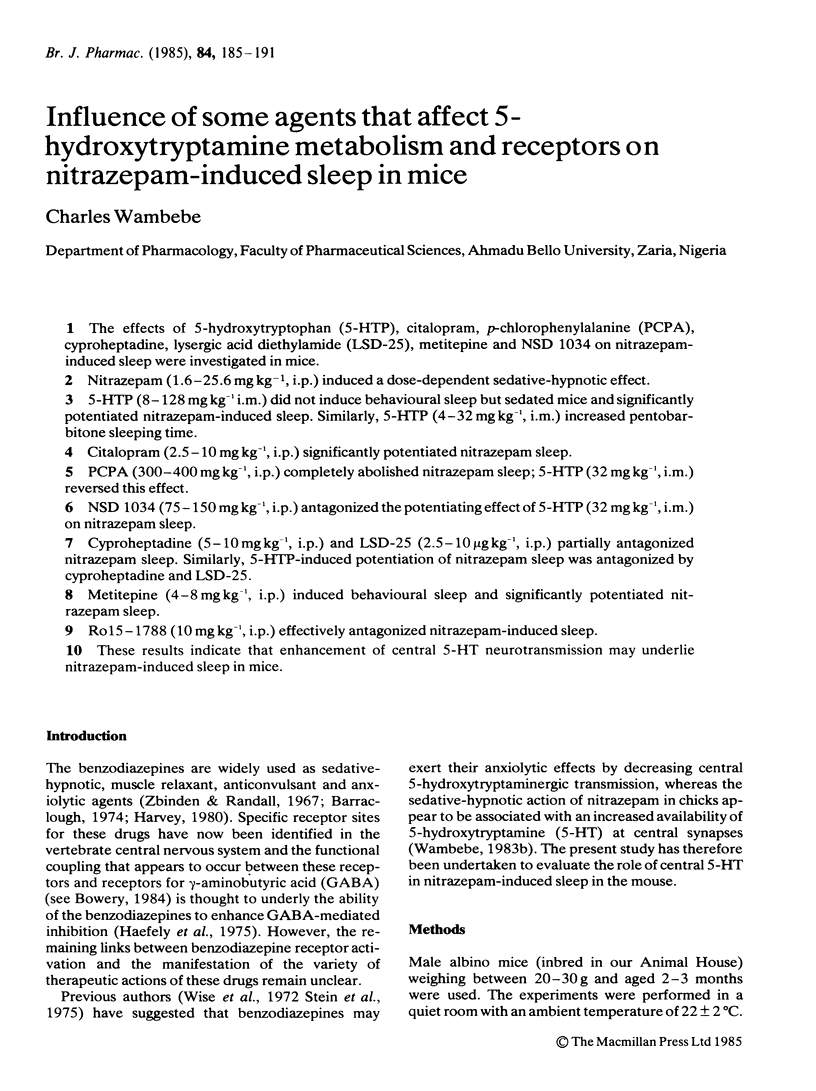

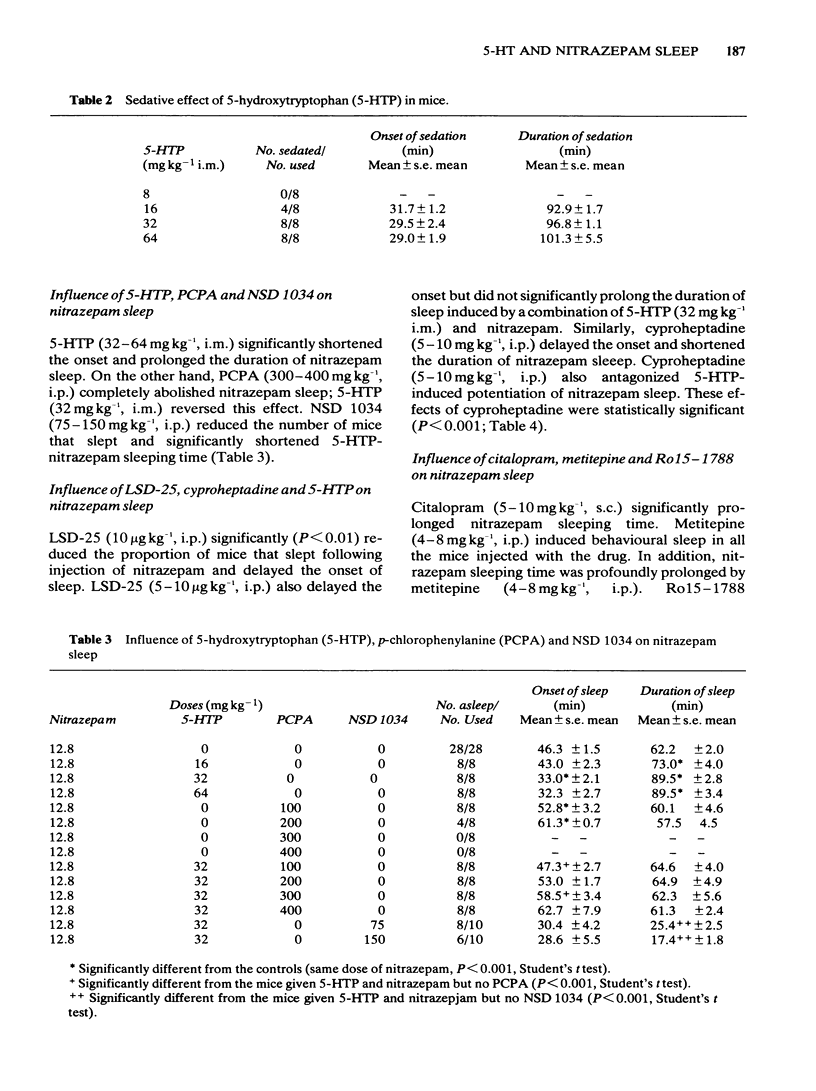
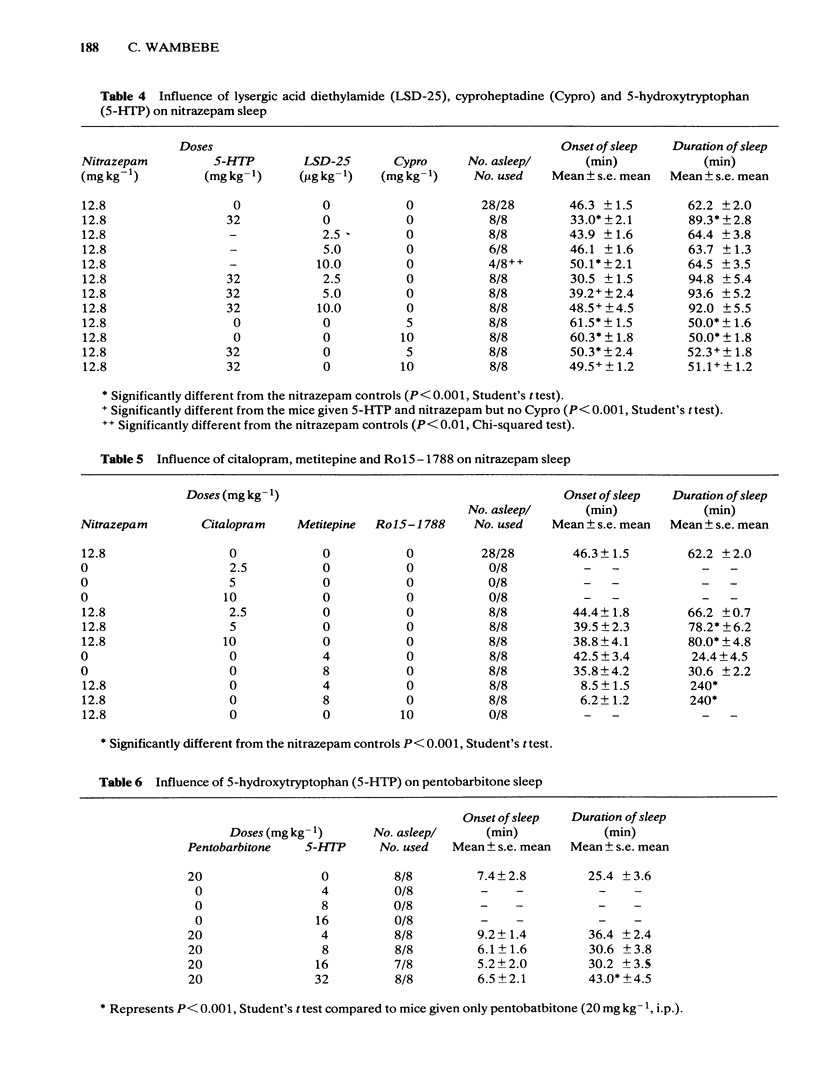
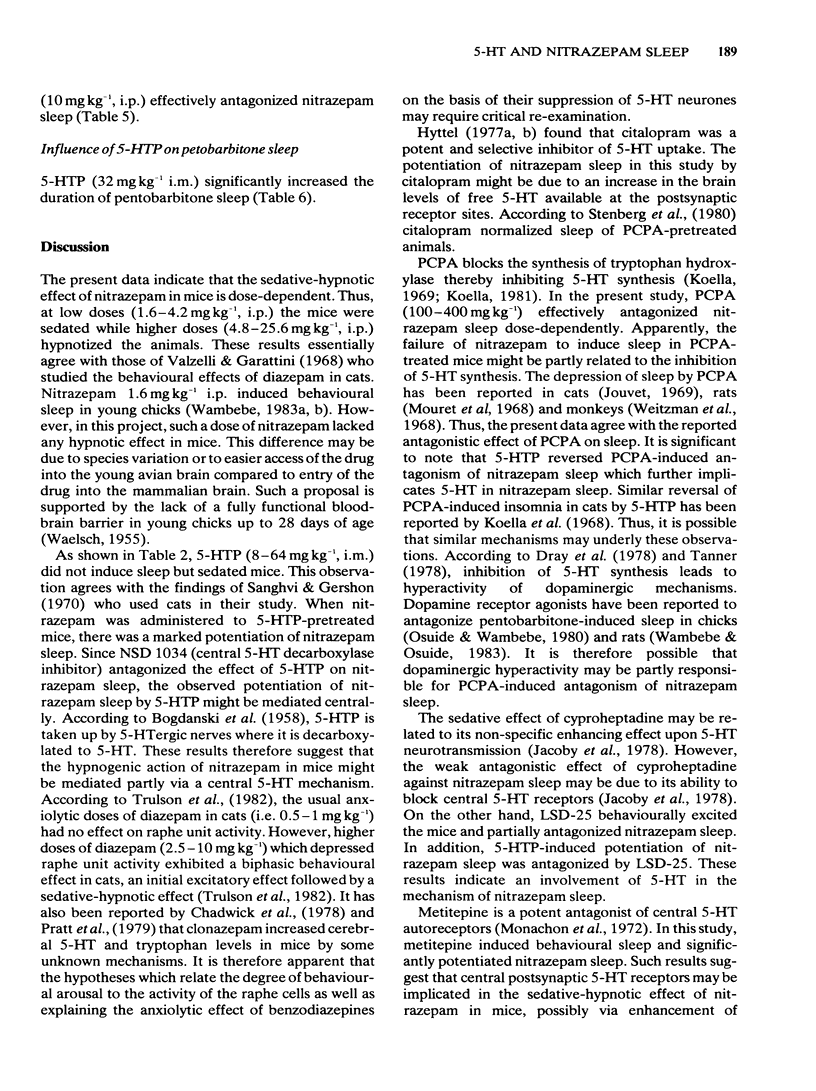
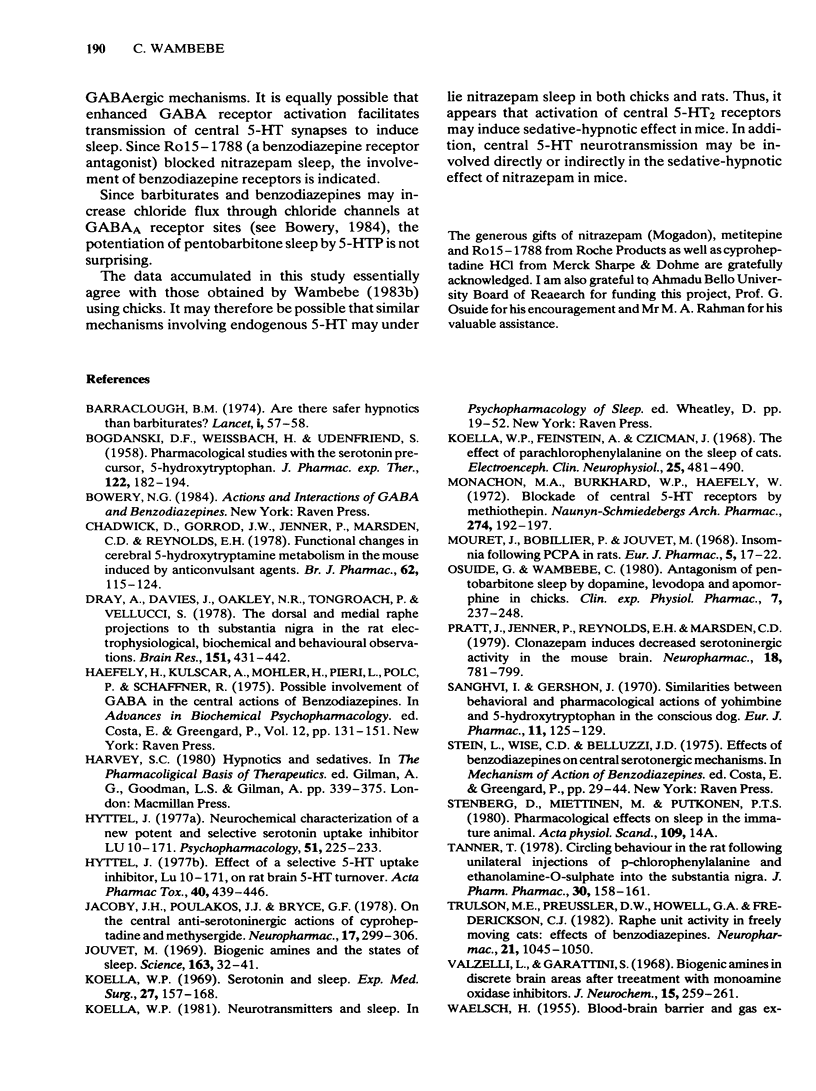
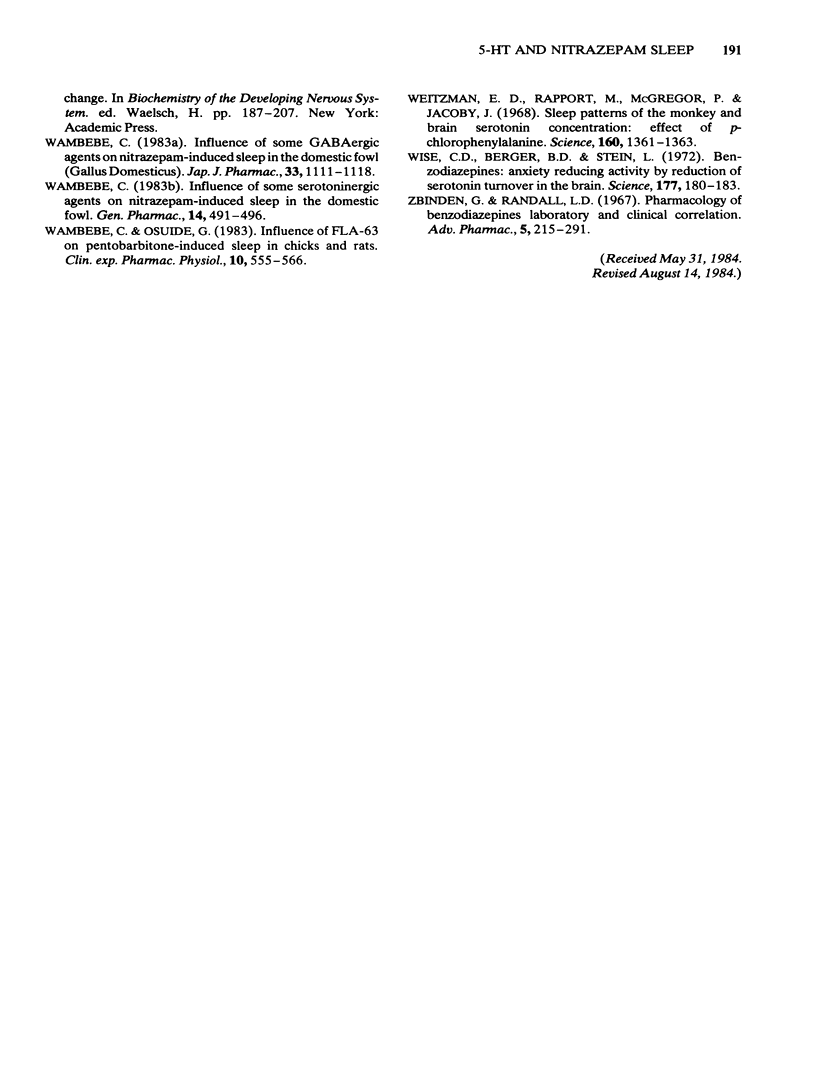
Selected References
These references are in PubMed. This may not be the complete list of references from this article.
- BOGDANSKI D. F., WEISSBACH H., UDENFRIEND Pharmacological studies with the serotonin precursor, 5-hydroxytryptophan. J Pharmacol Exp Ther. 1958 Feb;122(2):182–194. [PubMed] [Google Scholar]
- Barraclough B. M. Are there safer hypnotics than barbiturates? Lancet. 1974 Jan 12;1(7846):57–58. doi: 10.1016/s0140-6736(74)93055-4. [DOI] [PubMed] [Google Scholar]
- Chadwick D., Gorrod J. W., Jenner P., Marsden C. D., Reynolds E. H. Functional changes in cerebral 5-hydroxytryptamine metabolism in the mouse induced by anticonvulsant drugs. Br J Pharmacol. 1978 Jan;62(1):115–124. doi: 10.1111/j.1476-5381.1978.tb07013.x. [DOI] [PMC free article] [PubMed] [Google Scholar]
- Dray A., Davies J., Oakley N. R., Tongroach P., Vellucci S. The dorsal and medial raphe projections to the substantia nigra in the rat: electrophysiological, biochemical and behavioural observations. Brain Res. 1978 Aug 11;151(3):431–442. doi: 10.1016/0006-8993(78)91077-6. [DOI] [PubMed] [Google Scholar]
- Haefely W., Kulcsár A., Möhler H., Pieri L., Polc P., Schaffner R. Possible involvement of GABA in the central actions of benzodiazepines. Adv Biochem Psychopharmacol. 1975;(14):131–151. [PubMed] [Google Scholar]
- Hyttel J. Neurochemical characterization of a new potent and selective serotonin uptake inhibitor: Lu 10-171. Psychopharmacology (Berl) 1977 Mar 16;51(3):225–233. doi: 10.1007/BF00431629. [DOI] [PubMed] [Google Scholar]
- Jacoby J. H., Poulakos J. J., Bryce G. F. On the central anti-serotoninergic actions of cyproheptadine and methysergide. Neuropharmacology. 1978 Apr-May;17(4-5):299–306. doi: 10.1016/0028-3908(78)90115-6. [DOI] [PubMed] [Google Scholar]
- Jouvet M. Biogenic amines and the states of sleep. Science. 1969 Jan 3;163(3862):32–41. doi: 10.1126/science.163.3862.32. [DOI] [PubMed] [Google Scholar]
- Koella W. P., Feldstein A., Czicman J. S. The effect of para-chlorophenylalanine on the sleep of cats. Electroencephalogr Clin Neurophysiol. 1968 Nov;25(5):481–490. doi: 10.1016/0013-4694(68)90158-2. [DOI] [PubMed] [Google Scholar]
- Koella W. P. Serotonin and sleep. Exp Med Surg. 1969;27(1-2):157–168. [PubMed] [Google Scholar]
- Monachon M. A., Burkard W. P., Jalfre M., Haefely W. Blockade of central 5-hydroxytryptamine receptors by methiothepin. Naunyn Schmiedebergs Arch Pharmacol. 1972;274(2):192–197. doi: 10.1007/BF00501854. [DOI] [PubMed] [Google Scholar]
- Mouret J., Bobillier P., Jouvet M. Insomnia following parachlorophenylalanine in the rat. Eur J Pharmacol. 1968 Dec;5(1):17–22. doi: 10.1016/0014-2999(68)90151-9. [DOI] [PubMed] [Google Scholar]
- Osuide G., Wambebe C. Antagonism of pentobarbitone sleep by dopamine, levodopa and apomorphine in chicks. Clin Exp Pharmacol Physiol. 1980 May-Jun;7(3):237–248. doi: 10.1111/j.1440-1681.1980.tb00068.x. [DOI] [PubMed] [Google Scholar]
- Pratt J., Jenner P., Reynolds E. H., Marsden C. D. Clonazepam induces decreased serotoninergic activity in the mouse brain. Neuropharmacology. 1979 Oct;18(10):791–799. doi: 10.1016/0028-3908(79)90024-8. [DOI] [PubMed] [Google Scholar]
- Sanghvi I., Gershon S. Similarities between behavioral and pharmacological actions of yohimbine and 5-hydroxytryptophan in the conscious dog. Eur J Pharmacol. 1970 Jul 15;11(2):125–129. doi: 10.1016/0014-2999(70)90041-5. [DOI] [PubMed] [Google Scholar]
- Stein L., Wise C. D., Belluzzi J. D. Effects of benzodiazepines on central serotonergic mechanisms. Adv Biochem Psychopharmacol. 1975;(14):29–44. [PubMed] [Google Scholar]
- Tanner T. Circling behaviour in the rat following unilateral injections of p-chlorophenylalanine and ethanolamine-O-sulphate into the substantia nigra. J Pharm Pharmacol. 1978 Mar;30(3):158–161. doi: 10.1111/j.2042-7158.1978.tb13188.x. [DOI] [PubMed] [Google Scholar]
- Valzelli L., Garattini S. Biogenic amines in discrete brain areas after treatment with monoamineoxidase inhibitors. J Neurochem. 1968 Mar;15(3):259–261. doi: 10.1111/j.1471-4159.1968.tb06205.x. [DOI] [PubMed] [Google Scholar]
- Wambebe C. Influence of some GABAergic agents on nitrazepam-induced sleep in the domestic fowl (Gallus domesticus). Jpn J Pharmacol. 1983 Dec;33(6):1111–1118. doi: 10.1254/jjp.33.1111. [DOI] [PubMed] [Google Scholar]
- Wambebe C. Influence of some serotoninergic agents on nitrazepam-induced sleep in the domestic fowl (Gallus domesticus). Gen Pharmacol. 1983;14(5):491–495. doi: 10.1016/0306-3623(83)90108-8. [DOI] [PubMed] [Google Scholar]
- Wambebe C., Osuide G. Influence of FLA-63 on pentobarbitone sleep in chicks and rats. Clin Exp Pharmacol Physiol. 1983 Sep-Oct;10(5):555–566. doi: 10.1111/j.1440-1681.1983.tb00224.x. [DOI] [PubMed] [Google Scholar]
- Weitzman E. D., Rapport M. M., McGregor P., Jacoby J. Sleep patterns of the monkey and brain serotonin concentration: effect of p-chlorophenylalanine. Science. 1968 Jun 21;160(3834):1361–1363. doi: 10.1126/science.160.3834.1361. [DOI] [PubMed] [Google Scholar]
- Wise C. D., Berger B. D., Stein L. Benzodiazepines: anxiety-reducing activity by reduction of serotonin turnover in the brain. Science. 1972 Jul 14;177(4044):180–183. doi: 10.1126/science.177.4044.180. [DOI] [PubMed] [Google Scholar]
- Zbinden G., Randall L. O. Pharmacology of benzodiazepines: laboratory and clinical correlations. Adv Pharmacol. 1967;5:213–291. doi: 10.1016/s1054-3589(08)60658-4. [DOI] [PubMed] [Google Scholar]


